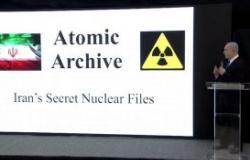Bizarre, Strange or Last Straw? Slideshows in International Relations

Last week, Israeli Prime Minister Benjamin Netanyahu made headlines with his PowerPoint presentation on Iran’s nuclear program. Media outlets talked of a ‘bizarre PowerPoint’, a ‘strange slideshow’ and deemed it unnecessary for Netanyahu ‘to convince us that you don’t support the Iran nuclear deal’. The slideshow quickly became a twitter meme.
What these reactions made me recall is how rare it is for heads of state or government officials to use PowerPoint slides, or any type of visualizations, to convey and illustrate information of international concern to the public. While PowerPoint is a medium of debatable value, nonetheless, we all use it frequently to present complex information. It is the default medium in business and academia, but it is not the standard in politics. Why don’t we see PowerPoint presentations more often?
Many political questions are incredibly complex, and a detailed slideshow at least recognizes that some effort has to be made to convince your audience, something we can hardly say of new media like Twitter. PowerPoint presentations could help politicians to highlight and emphasize key points through visual representations such as graphs, charts and pictures. Political speeches sometimes are hard to follow and key points of evidence may get lost – this is something that a PowerPoint presentation could help to avoid.
 But, here is the thing: while you may think that slides raise the standard of debate and evidence, the three most famous examples of political uses of slideshows that I’m aware of actually demonstrate the opposite. In all three cases it was quickly pointed out by observers that the information was not particularly new, spun in a very favorable light or was misleading. The most common reaction that Netanyahu’s presentation seems to have been “Iran lied? Tell us something new.”
But, here is the thing: while you may think that slides raise the standard of debate and evidence, the three most famous examples of political uses of slideshows that I’m aware of actually demonstrate the opposite. In all three cases it was quickly pointed out by observers that the information was not particularly new, spun in a very favorable light or was misleading. The most common reaction that Netanyahu’s presentation seems to have been “Iran lied? Tell us something new.”
 During my research on Reagan’s Strategic Defense Initiative (SDI),[1] I incredulously watched his March 23, 1983 speech, broadcast on national television, in which Reagan introduced the idea of a space-based missile defense system. It includes slides, similar to a PowerPoint, which was not around at the time, to convince the public that defense spending was inadequate and a missile defense system needed to contain the ‘awesome Soviet missile threat’. The slides intended to demonstrate inadequate defense spending speak for themselves:
During my research on Reagan’s Strategic Defense Initiative (SDI),[1] I incredulously watched his March 23, 1983 speech, broadcast on national television, in which Reagan introduced the idea of a space-based missile defense system. It includes slides, similar to a PowerPoint, which was not around at the time, to convince the public that defense spending was inadequate and a missile defense system needed to contain the ‘awesome Soviet missile threat’. The slides intended to demonstrate inadequate defense spending speak for themselves:
Besides Netanyahu’s presentation on Iran and Reagan’s on the need for SDI, Colin Powell’s presentation to the United Nations (UN) Security Council of 5 February 2003 on Iraq’s alleged weapons of mass destruction (WMD) program comes to mind. Infamously, despite Colin Powell’s audio-visual evidence of a WMD program in Iraq, the proof was not in the pudding.

What may partly answer the question ‘why we don’t see more slideshows?’ is that slides provide a more tangible reference point and make it easier for the vigilant eye of the public to pick apart evidence. Hence, the observation about the quality of these PowerPoint presentations raises an even bigger question: why would you display trivial, selective, unsubstantiated or otherwise uncompelling information so publicly?
Desperate situations call for desperate measures. In each example discussed, things weren’t going well before they resorted to slideshows; something had to be done to convince audiences and to help their case. While there are ‘lies, damned lies, and statistics,’ we also know that numbers and figures can come across as facts and are likely to impress. There is some hope that the audience that matters can be impressed – something Netanyahu, Reagan and the Bush administration may have been banking on. The slides may have even convinced the presenters, as Colin Powell’s admission that he was ‘devastated’ to learn later that the information he presented was unreliable indicates.
When it comes to Netanyahu, it is not exactly a secret that Israel is not very happy about the nuclear deal with Iran, but Netanyahu has not been able to make much headway in convincing those who are part of the deal that it has to be scrapped. The one exception is Trump, who has publicly assailed the Iran nuclear deal and in May will decide about its reauthorisation. Hence, Netanyahu may have been thinking of an audience of one, which would also explain him conducting the presentation primarily in English. As Matthew Norman notes in the Independent:“[on] the relatively sane listener, Netanyahu’s presentation will have had the opposite effect to the one intended […] Since he was effectively addressing an audience of one, and since the lone audience member was Donald Trump, one appreciates why [he held the presentation].”
 Similarly, Reagan was backed into a corner at the time. The nuclear freeze movement was on the rise, opposition to large defense budgets was forming, and his approval ratings were low. However, Reagan believed that a defensive system was necessary to achieve his goal to render ‘nuclear weapons impotent and obsolete’. This required vast amounts of funding. Thus, he went on the offensive with a national TV address. Reagan’s speech attracted much ridicule the next day in Congress and from the media. The speech and policy were dubbed ‘Star Wars’ to communicate the fantastical and dangerous nature of it. The graphs and slides were not discussed much, albeit the Washington Post noted that the focus of the speech was on the Soviet missile threat rather than on the cost of the policy.[2] Perhaps due to this backlash, the Reagan administration didn’t seriously pursue SDI until a couple of years later.
Similarly, Reagan was backed into a corner at the time. The nuclear freeze movement was on the rise, opposition to large defense budgets was forming, and his approval ratings were low. However, Reagan believed that a defensive system was necessary to achieve his goal to render ‘nuclear weapons impotent and obsolete’. This required vast amounts of funding. Thus, he went on the offensive with a national TV address. Reagan’s speech attracted much ridicule the next day in Congress and from the media. The speech and policy were dubbed ‘Star Wars’ to communicate the fantastical and dangerous nature of it. The graphs and slides were not discussed much, albeit the Washington Post noted that the focus of the speech was on the Soviet missile threat rather than on the cost of the policy.[2] Perhaps due to this backlash, the Reagan administration didn’t seriously pursue SDI until a couple of years later.
Lastly, it is common knowledge that at the time of Powell’s speech, the United States and the United Kingdom had not convinced critical UN Security Council members of the need for an intervention in Iraq. The Chilcot Inquiry shows that there was awareness among leading decision-makers that they needed a ‘silver bullet’[3], that is evidence of WMDs, to persuade skeptics to issue an unambiguous UN mandate for intervention.
Despite being often dismissed and ridiculed by the media and eliciting a shrug from expert audiences, audio-visual presentations might play a role in successfully selling the public on an idea. For instance, Reagan’s speech was very successful with the American public. The missile defense idea received between 70 and 80 percent of approval in polls conducted shortly afterward.[4] This number would decline over the years, but it indicates that the slides may have helped to impress an audience whose opinion counts. While Powell’s presentation failed to convince the other UN Security Council members, opinion polls show that the audio-visual evidence Powell presented may have persuaded voters: 55% of those who watched the presentation backed intervention, whereas only 41% of those who didn’t approved. Further, approval for a US intervention without a ‘coalition of the willing’ rose from 37% in December 2002 to 50% after Powell’s presentation. Trying to primarily convince Trump, whose famously short attention span means he is not an avid reader of complicated briefings, Netanyahu might have liked his chances in using his PowerPoint presentation.
What can we conclude from all this? When you see a slideshow in international relations, this is not necessarily a sign of significant evidence, but instead of someone who is desperate to impress.
Anette Stimmer is a DPhil student of International Relations at the University of Oxford, Nuffield College. She is currently doing research on norm contestation.
This post first appeared on OxPol.
[1] Annete Stimmer is fascinated by the discussion over the Strategic Defense Initiative, so when her husband asked her to compare Netanyahu’s presentation to Reagan’s, the idea for this blog post was born
[2]Lou Cannon. 1983. “President Seeks Futuristic Defense Against Missiles.” The Washington Post. March 24.
[3]Report of the Iraq Inquiry. 2016. “Section 4.3 – Iraq WMD assessments, October 2002 to March 2003,” para 177-178.
[4]Peter Krämer, “Fighting the Evil Empire: Star Wars, the Strategic Defense Initiative, and the Politics of Science Fiction,” in Sex, Politics, and Religion in Star Wars: An Anthology, ed. Douglas Brode and Leah Dyneka (Lanham, Md: Scarecrow Press, 2012), p. 67.


